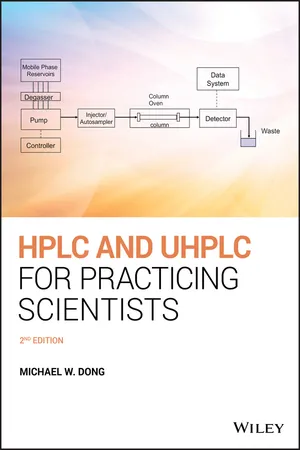
- English
- ePUB (mobile friendly)
- Available on iOS & Android
HPLC and UHPLC for Practicing Scientists
About this book
A concise yet comprehensive reference guide on HPLC/UHPLC that focuses on its fundamentals, latest developments, and best practices in the pharmaceutical and biotechnology industries
Written for practitioners by an expert practitioner, this new edition of HPLC and UHPLC for Practicing Scientists adds numerous updates to its coverage of high-performance liquid chromatography, including comprehensive information on UHPLC (ultra-high-pressure liquid chromatography) and the continuing migration of HPLC to UHPLC, the modern standard platform. In addition to introducing readers to HPLC's fundamentals, applications, and developments, the book describes basic theory and terminology for the novice, and reviews relevant concepts, best practices, and modern trends for the experienced practitioner.
HPLC and UHPLC for Practicing Scientists, Second Edition offers three new chapters. One is a standalone chapter on UHPLC, covering concepts, benefits, practices, and potential issues. Another examines liquid chromatography/mass spectrometry (LC/MS). The third reviews at the analysis of recombinant biologics, particularly monoclonal antibodies (mAbs), used as therapeutics. While all chapters are revised in the new edition, five chapters are essentially rewritten (HPLC columns, instrumentation, pharmaceutical analysis, method development, and regulatory aspects). The book also includes problem and answer sections at the end of each chapter.
- Overviews fundamentals of HPLC to UHPLC, including theories, columns, and instruments with an abundance of tables, figures, and key references
- Features brand new chapters on UHPLC, LC/MS, and analysis of recombinant biologics
- Presents updated information on the best practices in method development, validation, operation, troubleshooting, and maintaining regulatory compliance for both HPLC and UHPLC
- Contains major revisions to all chapters of the first edition and substantial rewrites of chapters on HPLC columns, instrumentation, pharmaceutical analysis, method development, and regulatory aspects
- Includes end-of-chapter quizzes as assessment and learning aids
- Offers a reference guide to graduate students and practicing scientists in pharmaceutical, biotechnology, and other industries
Filled with intuitive explanations, case studies, and clear figures, HPLC and UHPLC for Practicing Scientists, Second Edition is an essential resource for practitioners of all levels who need to understand and utilize this versatile analytical technology. It will be a great benefit to every busy laboratory analyst and researcher.
Frequently asked questions
- Essential is ideal for learners and professionals who enjoy exploring a wide range of subjects. Access the Essential Library with 800,000+ trusted titles and best-sellers across business, personal growth, and the humanities. Includes unlimited reading time and Standard Read Aloud voice.
- Complete: Perfect for advanced learners and researchers needing full, unrestricted access. Unlock 1.4M+ books across hundreds of subjects, including academic and specialized titles. The Complete Plan also includes advanced features like Premium Read Aloud and Research Assistant.
Please note we cannot support devices running on iOS 13 and Android 7 or earlier. Learn more about using the app.
Information
1
Introduction
1.1 INTRODUCTION
1.1.1 Scope
- A broad‐scope overview of fundamental principles, instrumentation, columns, and applications.
- A concise review of concepts and trends of modern HPLC.
- An update of best practices in HPLC operation, method development, maintenance, troubleshooting, and regulatory aspects in analytical testing.
- New standalone overview chapters on UHPLC, LC/MS, and analysis of recombinant biologics.
1.1.2 What Is HPLC?

1.1.3 A Brief History
Table of contents
- Cover
- Table of Contents
- Author's Biography
- Biographies of Contributors
- Preface
- Foreword
- Acknowledgments
- 1 Introduction
- 2 Basic Terms and Concepts
- 3 HPLC Columns and Trends
- 4 HPLC/UHPLC Instrumentation and Trends
- 5 UHPLC: Perspectives, Performance, Practices, and Potential Issues
- 6 LC/MS: Fundamentals, Perspectives, and Applications
- 7 HPLC/UHPLC Operation Guide
- 8 HPLC/UHPLC Maintenance and Troubleshooting
- 9 Pharmaceutical Analysis
- 10 HPLC Method Development
- 11 Regulations, HPLC System Qualification, Method Validation, and Transfer
- 12 HPLC and UHPLC for Biopharmaceutical Analysis
- 13 HPLC Applications in Food, Environmental, Chemical, and Life Sciences Analysis
- Appendix Keys to Quizzes
- Index
- End User License Agreement